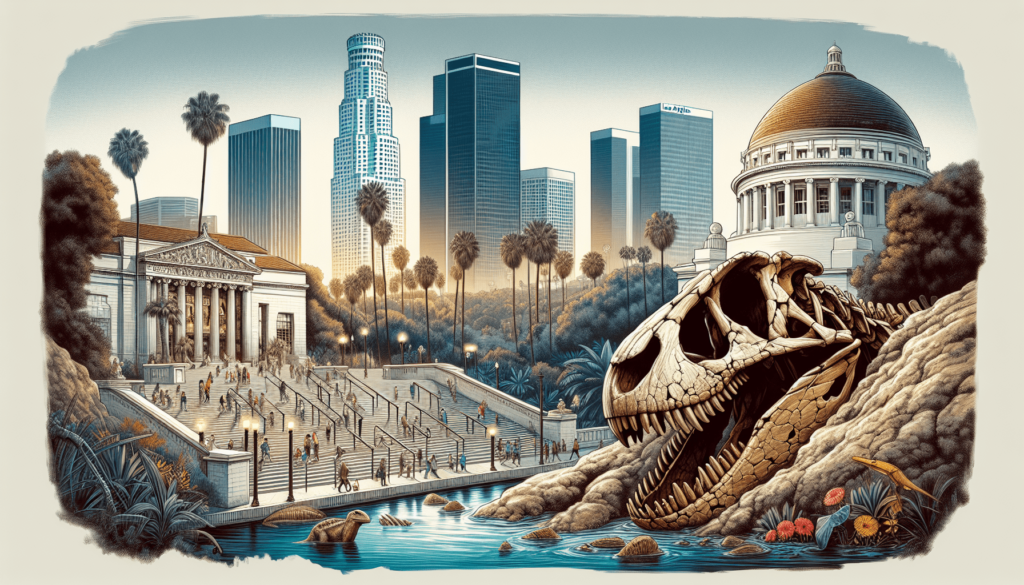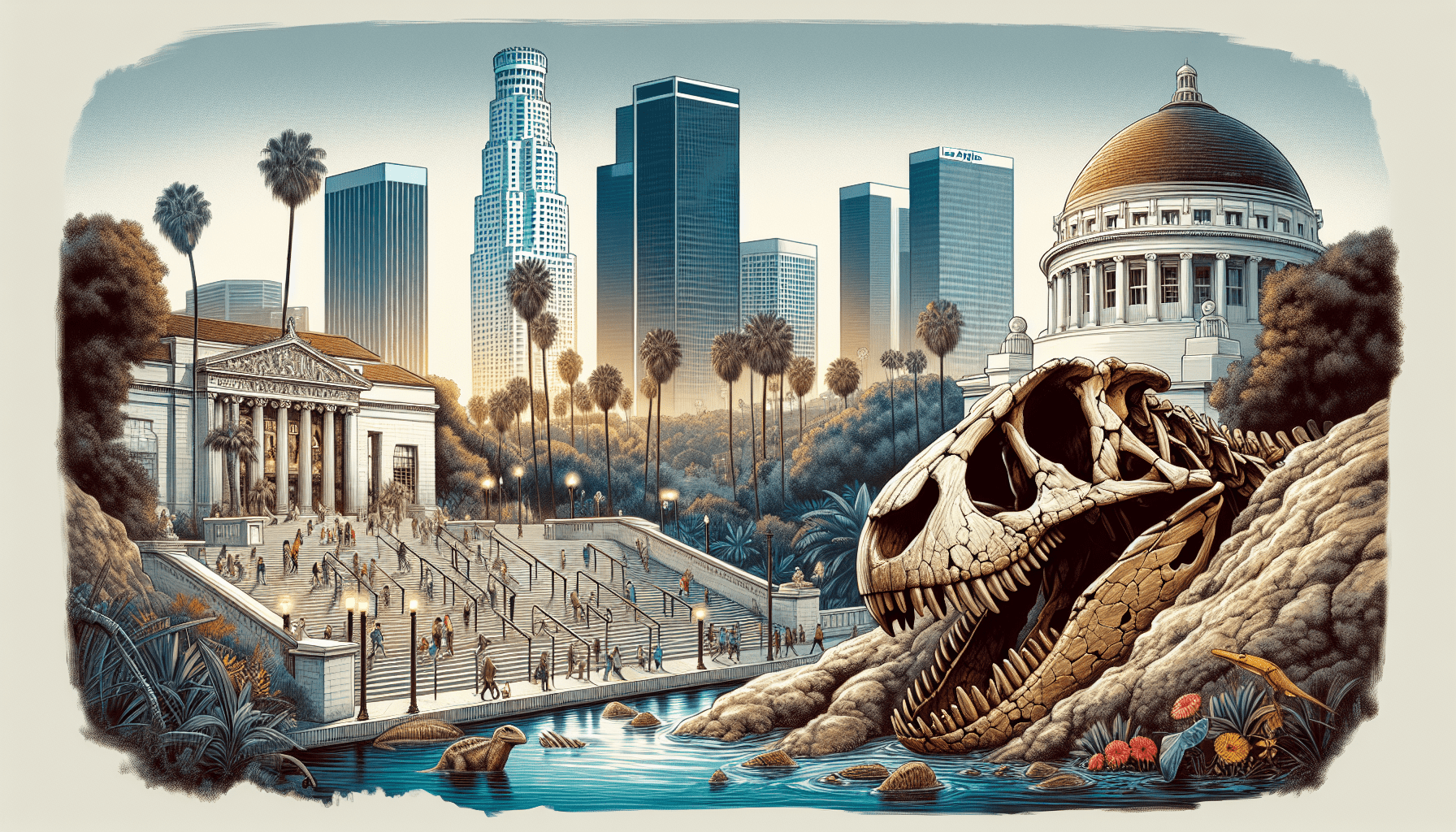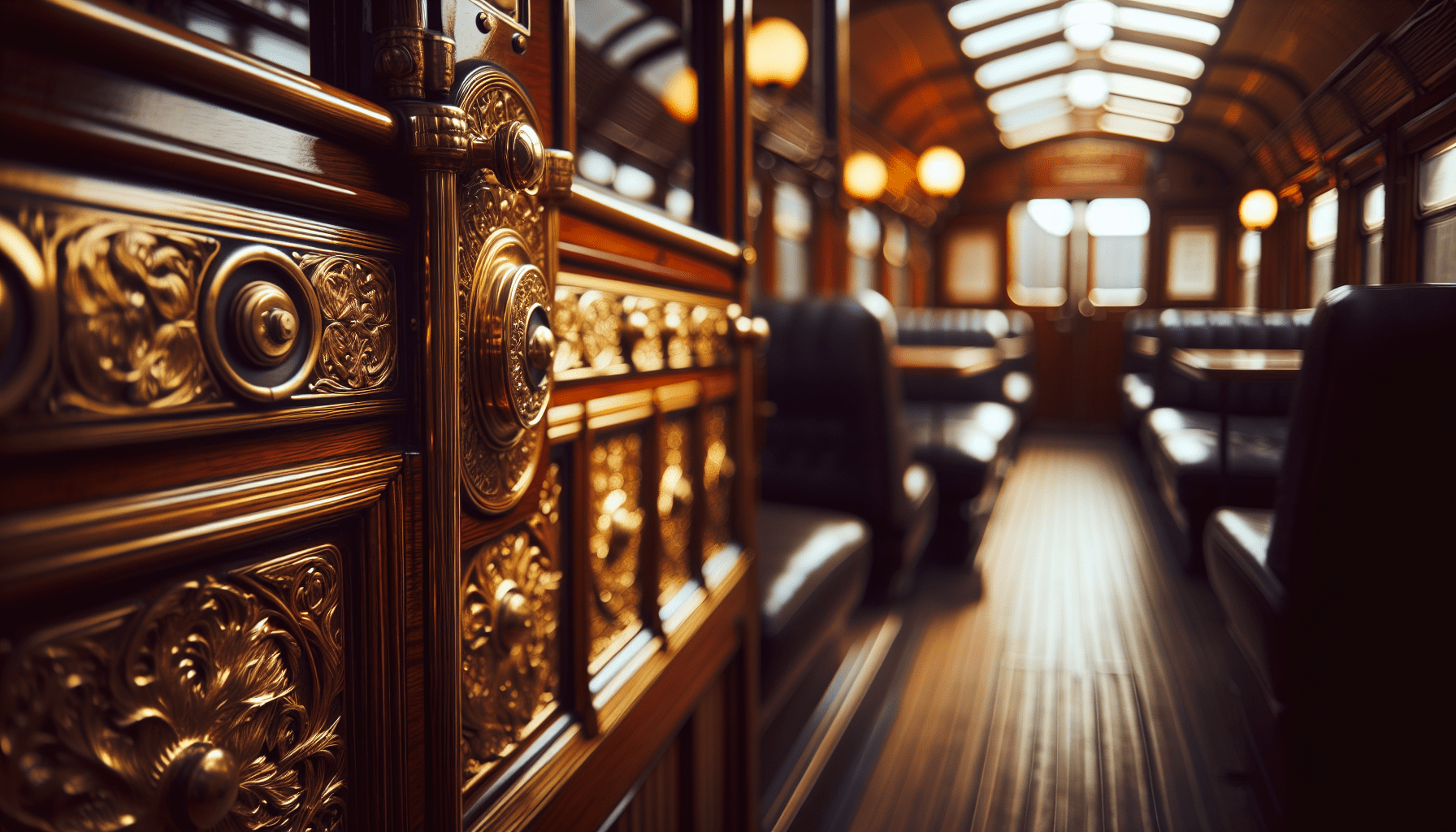DEPOZA 16 Pack Travel Bottles Set - TSA Approved Leak Proof Silicone Squeezable Containers for Toiletries, Conditioner, Shampoo, Lotion & Body Wash Accessories (16 pcs/Black Pack)
$9.99 (as of April 16, 2025 04:30 GMT +00:00 - More info)Once upon a time, in a place called Los Angeles, there was a very special museum called the La Brea Tar Pits and Museum. This museum was not like any other museum, because it had something really amazing – giant pools of sticky, gooey tar! These tar pits are like a time machine, taking us all the way back to when huge creatures called mammoths and saber-toothed cats roamed the Earth. But don’t worry, you won’t get stuck in the tar! Inside the museum, there are cool exhibits and real fossils that teach us all about these ancient animals. It’s a place where learning and adventure come together, and it’s waiting for us to explore!
History
Formation of the Tar Pits
The La Brea Tar Pits, located in Los Angeles, California, were formed thousands of years ago during the last Ice Age. The area was once covered by a large lake, and over time, natural asphalt or tar started seeping up to the surface. This sticky tar trapped animals that came too close, creating a unique fossil record.
Discovery and early excavation
The tar pits were discovered by early settlers in the 18th century, who initially used the tar for various purposes like caulking ships and making torches. However, it wasn’t until the early 20th century that scientists realized the incredible value of the tar pits as a treasure trove of ancient fossils.
Excavations at the La Brea Tar Pits began in the early 1900s, led by paleontologists and archaeologists. These dedicated scientists carefully dug out fossils of animals like mammoths, saber-toothed cats, and dire wolves, providing valuable insights into the prehistoric world. The discoveries made at the tar pits have greatly contributed to our understanding of the animals that lived during the last Ice Age.
Development of the museum
In 1977, the Page Museum was established next to the tar pits to showcase the incredible finds from the excavations. The museum was named after its founder, George C. Page, who played a crucial role in preserving the fossils and creating a space for public education and enjoyment.
Since then, the museum has undergone renovations and expansions to provide a fascinating experience for visitors. Today, the La Brea Tar Pits and Museum is a world-renowned institution that attracts people from all over the globe, eager to learn about the ancient past preserved within the tar pits.
Geology of the Tar Pits
Location and composition
Located in the heart of Los Angeles, the La Brea Tar Pits are situated within Hancock Park. The tar pits themselves are made up of natural asphalt, which is a thick, sticky substance that oozes up from the ground. This asphalt is composed of petroleum that has been altered over thousands of years, providing an ideal environment for fossil preservation.
Tar seepage and preservation
The tar seeps up from deep underground, forming small pools or puddles on the surface. These pools might seem like harmless patches of water, but they are actually treacherous for unsuspecting animals. When an animal, such as a mammoth or a saber-toothed cat, unwittingly steps into the tar, it becomes trapped.
Over time, the tar hardens, creating a tomb for the unfortunate animal. This incredible preservation process has allowed scientists to uncover the remains of countless prehistoric creatures, giving us a glimpse into their lives millions of years ago.
Fossil discoveries
The fossil record at the La Brea Tar Pits is remarkable. From giant sloths and mammoths to sabertooth cats and dire wolves, scientists have uncovered a wide variety of species that lived during the Ice Age. These fossils have provided significant information about the ecosystems and biodiversity of the ancient world.
The tar pits have also yielded smaller fossils, such as insects and plants. These tiny specimens help scientists understand the entire ecosystem that existed in the area during prehistoric times. By studying these fossils, researchers have been able to piece together a puzzle of life during the Ice Age.
Exhibits
Fossil Lab
The Fossil Lab at the La Brea Tar Pits and Museum offers visitors a unique opportunity to witness ongoing scientific research. In this interactive exhibit, you can observe paleontologists as they clean, study, and analyze fossils recovered from the tar pits. It’s like stepping into a real-life laboratory and seeing firsthand how scientists unravel the mysteries of the past.
Pleistocene Garden
Step into the Pleistocene Garden and take a journey back in time. This outdoor exhibit showcases plants that would have thrived during the Ice Age, allowing visitors to experience the environment that existed millions of years ago. Stroll through the garden and imagine yourself among woolly mammoths and giant ground sloths.
Project 23
Project 23 is an exciting exhibit that highlights an ongoing excavation at the tar pits. Visitors can see a working excavation site and watch as fossils are carefully excavated and cataloged. It’s a fascinating opportunity to witness the scientific process in action and be a part of the discovery of new prehistoric treasures.
Fishbowl Lab
The Fishbowl Lab provides a unique glimpse into the world of paleontology. Visitors can peer through the glass walls of the lab and watch as scientists analyze and study fossil specimens. This behind-the-scenes view gives a firsthand look at the meticulous work that goes into understanding our ancient past.

The Page Museum
Architecture and design
The Page Museum, designed by architect Frank O. Gehry, is an architectural marvel. Its unique steel canopy and curving walls reflect the organic shapes found in nature and pay homage to the tar pits themselves. The building’s design is an excellent backdrop for the ancient treasures contained within.
Collections and displays
The museum houses an impressive collection of fossils that were discovered at the tar pits. From the bones of massive mammoths to the teeth of fearsome saber-toothed cats, the exhibits provide a captivating display of prehistoric life. The carefully curated displays offer a glimpse into the world of these long-extinct creatures.
Visiting hours and ticket prices
The La Brea Tar Pits and Museum is open daily from 9:30 am to 5:00 pm. However, it is always a good idea to check the museum’s website for any changes or special events. Ticket prices vary depending on age and residency, with discounts available for children, students, and seniors. It’s best to purchase tickets online in advance to skip the line and guarantee entry.
Tar Pit Theater
Shows and presentations
The Tar Pit Theater offers visitors a chance to watch fascinating films and presentations related to the tar pits and the ancient world. From educational documentaries on prehistoric life to interactive presentations led by paleontologists, there’s always something exciting happening in the theater. These shows bring the past to life and provide a deeper understanding of the incredible fossils found at the tar pits.
Educational programs
The La Brea Tar Pits and Museum offers a range of educational programs for visitors of all ages. Children can participate in hands-on workshops where they can become paleontologists for a day, uncovering fossils and learning about the process of fossilization. The museum also offers school programs, summer camps, and educational resources for teachers, ensuring that learning is fun and engaging for young minds.
Special events
Throughout the year, the museum hosts special events that celebrate the wonders of prehistoric Los Angeles. From family-friendly festivals to exclusive lectures by leading scientists, these events provide unique experiences for visitors. Check the museum’s website for a calendar of upcoming events and make sure not to miss out on these exciting opportunities.
Nearby Attractions
Los Angeles County Museum of Art
Located just a short distance from the La Brea Tar Pits, the Los Angeles County Museum of Art (LACMA) is a must-visit attraction. With its extensive collection of art from different periods and cultures, LACMA offers a different kind of journey through history and creativity. From ancient Egyptian artifacts to contemporary masterpieces, this world-class museum has something for everyone.
The Grove
For a unique shopping and dining experience, head to The Grove. This outdoor shopping center, located near the tar pits, offers a vibrant atmosphere filled with shops, restaurants, and entertainment options. Take a stroll through the beautifully landscaped gardens, enjoy live music, or catch a movie at the theater. The Grove is a perfect place to unwind and relax after a visit to the tar pits.
Farmers Market
Right next to The Grove is the historic Farmers Market. This iconic destination has been a gathering place for locals and visitors alike since 1934. With its wide variety of food stalls, fresh produce, and specialty shops, the Farmers Market is a food lover’s paradise. Grab a bite to eat, explore the unique vendors, and soak in the lively atmosphere.
Melrose Avenue
If you’re looking for a trendy and eclectic experience, head to Melrose Avenue. Known for its hip boutiques, vintage shops, and street art, Melrose Avenue offers a vibrant and colorful atmosphere. Take a leisurely stroll down the avenue, discover unique fashion finds, and immerse yourself in the vibrant culture of Los Angeles.
Looking for Sightseeing Tours?
Guided Tours
Excavator Tour
Embark on an Excavator Tour and get a close-up look at the ongoing excavations at the tar pits. Led by knowledgeable guides, this tour takes visitors to active dig sites, providing a behind-the-scenes glimpse into the world of paleontology. It’s an exciting opportunity to witness the discovery of new fossils and learn about the scientific techniques used in the field.
Ice Age Encounters
Ice Age Encounters is a thrilling live performance that brings prehistoric creatures to life. Join a charismatic paleontologist as they introduce you to some of the amazing animals that once roamed the earth. This interactive show is both educational and entertaining, engaging visitors of all ages in a captivating journey through time.
Behind-the-Scenes Museum Tour
For a deeper understanding of the La Brea Tar Pits and Museum, go on a Behind-the-Scenes Museum Tour. Led by knowledgeable staff, this tour takes visitors to areas not open to the general public, providing insights into the museum’s operations and giving a glimpse of the incredible collections behind the scenes. It’s a unique opportunity to see the inner workings of this world-class institution.
Visitor Information
Location and directions
The La Brea Tar Pits and Museum is located at 5801 Wilshire Blvd, Los Angeles, California. It is situated within Hancock Park, near the intersection of Wilshire Blvd and Curson Ave. Visitors can easily reach the museum by car, bus, or even by bike.
Parking and transportation
The museum offers parking facilities for visitors, with both metered street parking and paid parking lots available nearby. However, parking can be limited, especially during peak times, so it’s advisable to arrive early or consider using public transportation. The museum is accessible by several bus lines, and there are also bike racks available for cyclists.
Accessibility and facilities
The La Brea Tar Pits and Museum is committed to providing an accessible and inclusive experience for all visitors. The museum offers wheelchair accessibility throughout its exhibits, as well as accessible restrooms. Additionally, the museum provides assistive listening devices and accessible entry points for individuals with disabilities. Visitors needing specific accommodations or assistance are encouraged to contact the museum in advance for a smooth and enjoyable visit.
Tips for Visitors
Best time to visit
The La Brea Tar Pits and Museum can be enjoyed at any time of the year. However, to beat the crowds, it’s best to visit during weekdays, especially in the morning. Early mornings provide a quieter and more relaxed atmosphere, allowing you to fully immerse yourself in the exhibits and enjoy the museum at your own pace.
What to wear
When visiting the La Brea Tar Pits and Museum, it’s important to dress comfortably. Wear clothing suitable for the weather, as some exhibits are outdoors. Comfortable shoes are recommended, as there is quite a bit of walking involved. Additionally, bring a hat and sunscreen if you plan to explore the Pleistocene Garden, as it can get sunny.
Photography restrictions
While photography is allowed at the La Brea Tar Pits and Museum, there are restrictions in certain areas. Flash photography is strictly prohibited, as it may damage the delicate fossils on display. Additionally, for the safety and enjoyment of all visitors, selfie sticks and tripods are not permitted inside the museum. Be respectful and follow any guidelines provided by museum staff to preserve the exhibits for future generations.
Looking for Sightseeing Packages?
Conclusion
The La Brea Tar Pits and Museum is a captivating destination that offers a unique glimpse into the ancient world of Los Angeles. Through its fascinating exhibits, interactive displays, and ongoing scientific research, the museum allows visitors of all ages to step back in time and discover the wonders of the prehistoric era.
From the formation of the tar pits to the discovery of incredible fossils, the rich history and geology of the site are brought to life. The museum’s architecture and design serve as a fitting backdrop for the priceless collection of prehistoric treasures on display.
Whether you’re exploring the Fossil Lab, walking through the Pleistocene Garden, or watching a show at the Tar Pit Theater, there’s something for everyone at the La Brea Tar Pits and Museum. It’s a place where science, discovery, and imagination converge, providing a truly unforgettable experience for visitors from near and far. By preserving the prehistoric past of Los Angeles, the museum ensures that we can all learn from and appreciate the remarkable world that existed millions of years ago.
Looking for Local Attractions?








